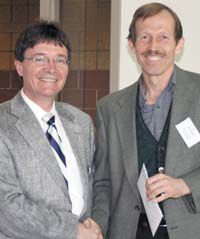| County Commissioner Bill Krompel receives Carbon’s SITLA monies from school and institutional lands representative Kevin Carter. |
During Sen. Bennett’s rural business conference on March 26, several Utah counties received past due payments from the state land exchange distribution account.
The mineral lease funds were distributed by Kevin Carter of the Utah School and Institutional Trust Lands Administration.
The SILTA payments were delivered by hand to the following counties:
•Carbon, $2,096,614.
•Emery, $1,980,520.
•Kane, $690,934.
•Garfield, $463,724.
•Sevier, $411,255.
•San Juan, $218,535.
•Cache, $91,122.
•Wayne, $88,594.
•Millard, $68,337.
•Juab, 43,480.
•Grand, 31,885.
Accepting the money on behalf of Carbon County was Commissioner Bill Krompel.
The commissioner clarified the point that the SILTA funds would not affect the county’s payment in lieu of taxes or PILT revenues allocated by the United States government.
“From now on, you will receive your money through the mail or electronically,” explained Carter. “We won’t be tracking you down to deliver the checks by hand but we felt it was important to deliver this years payment by hand here at the conference.”
The distribution account was created by the Utah Legislature in 2007 to redistribute part of the mineral lease revenues coming from state lands acquired from the U.S. government through federally established exchanges.
The SITLA payments represent one-half of a year’s earnings for the involved counties.
When Utah traded out of the Grand Staircase/Escalate National Monument, SILTA indicated that the state acquired federal lands with oil, gas and coal resources.
At the time of exchange between the state and federal governments, federal law provided that 50 percent of the mineral revenues generated on the lands in question would be shared with Utah.
To continue the flow of funds, SITLA agreed to direct one-half of the revenues from exchange lands to the state mineral lease account.
According to Carter, the intent of the exchange agreement was for revenues from exchange lands to flow through the state account to counties where the minerals were produced.
The state, however, reallocated part of the revenues in 1999 to other funds, including the Utah Permanent Community Impact Board.
Gov. Jon Huntsman’s natural resources extraction impact group recognized that Utah could not send the funds directly to counties, which is not permissible with federal mineral lease revenues, and recommended creation of the account to distribute the monies.
The account distributions allow local governments to decide how to mitigate adverse impacts attributable to mineral development on exchange lands without routing the money through the lease account or other entities.
Furthermore, the distribution account representatives send money back to the counties of extraction to mitigate impacts. They also send funds to counties which give up trust lands in land exchanges and thereby may lose the opportunity for economic development from said lands.
In Utah, 27 counties receive direct distribution of funds for these purposes.
Due to a clerical error, the 2007 Utah Legislature failed to appropriate funds for full distribution of all revenues collected by LEDA.
In 2008, state lawmakers allocated supplemental appropriations for all amounts collected in the fiscal year and fully authorized distributions for fiscal year 2009, according to SITLA.
“The current checks represent slightly more than two quarters of productions. Future distributions will be made quarterly,” said Carter.
Revenues from future land exchanges enacted by Congress will be distributed similarly based on trust lands given up and on mineral lands acquired in counties involved in the exchanges.

